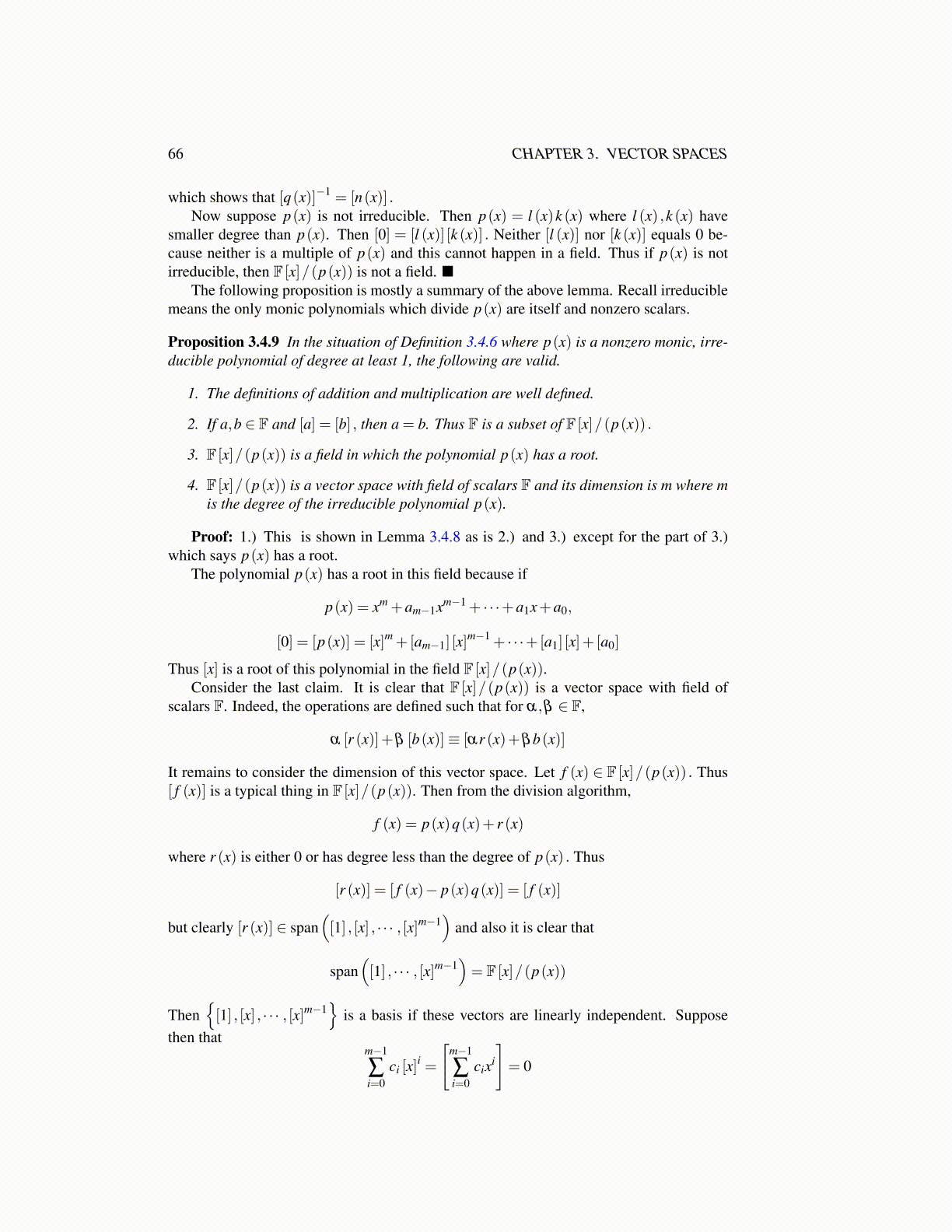
66 CHAPTER 3. VECTOR SPACES
which shows that [q(x)]−1 = [n(x)] .Now suppose p(x) is not irreducible. Then p(x) = l (x)k (x) where l (x) ,k (x) have
smaller degree than p(x). Then [0] = [l (x)] [k (x)] . Neither [l (x)] nor [k (x)] equals 0 be-cause neither is a multiple of p(x) and this cannot happen in a field. Thus if p(x) is notirreducible, then F [x]/(p(x)) is not a field. ■
The following proposition is mostly a summary of the above lemma. Recall irreduciblemeans the only monic polynomials which divide p(x) are itself and nonzero scalars.
Proposition 3.4.9 In the situation of Definition 3.4.6 where p(x) is a nonzero monic, irre-ducible polynomial of degree at least 1, the following are valid.
1. The definitions of addition and multiplication are well defined.
2. If a,b ∈ F and [a] = [b] , then a = b. Thus F is a subset of F [x]/(p(x)) .
3. F [x]/(p(x)) is a field in which the polynomial p(x) has a root.
4. F [x]/(p(x)) is a vector space with field of scalars F and its dimension is m where mis the degree of the irreducible polynomial p(x).
Proof: 1.) This is shown in Lemma 3.4.8 as is 2.) and 3.) except for the part of 3.)which says p(x) has a root.
The polynomial p(x) has a root in this field because if
p(x) = xm +am−1xm−1 + · · ·+a1x+a0,
[0] = [p(x)] = [x]m +[am−1] [x]m−1 + · · ·+[a1] [x]+ [a0]
Thus [x] is a root of this polynomial in the field F [x]/(p(x)).Consider the last claim. It is clear that F [x]/(p(x)) is a vector space with field of
scalars F. Indeed, the operations are defined such that for α,β ∈ F,
α [r (x)]+β [b(x)]≡ [αr (x)+βb(x)]
It remains to consider the dimension of this vector space. Let f (x) ∈ F [x]/(p(x)) . Thus[ f (x)] is a typical thing in F [x]/(p(x)). Then from the division algorithm,
f (x) = p(x)q(x)+ r (x)
where r (x) is either 0 or has degree less than the degree of p(x) . Thus
[r (x)] = [ f (x)− p(x)q(x)] = [ f (x)]
but clearly [r (x)] ∈ span([1] , [x] , · · · , [x]m−1
)and also it is clear that
span([1] , · · · , [x]m−1
)= F [x]/(p(x))
Then{[1] , [x] , · · · , [x]m−1
}is a basis if these vectors are linearly independent. Suppose
then thatm−1
∑i=0
ci [x]i =
[m−1
∑i=0
cixi
]= 0